
The Retail Essentials: Why Are Product Reviews Important for Brands?
Word of mouth has always played an instrumental role in retail sales.
Ever since mass-produced goods started rolling off assembly lines, there was someone—a friend, a parent, a neighbor—waiting in the wings to say, “Nah, don’t buy that one. Buy this one instead.”
And we listen, don’t we? Because we trust the recommendations of others; we value the advice of people who have been there, bought that.
Which is why product reviews are so powerful.
Product reviews are basically word of mouth for the digital age, and it’s difficult to overstate their importance to online (and in-store) purchases. Reviews, after all, are often the difference between “buy now” and an abandoned shopping cart.
No wonder brands and retailers care immensely that online reviews are available in the right quantities and qualities to generate sales among shoppers.
Indeed, many shoppers today won’t pull the trigger on a purchase, particularly in a durable category like electronics, without first reading a product review or two...
...or 100 for that matter.
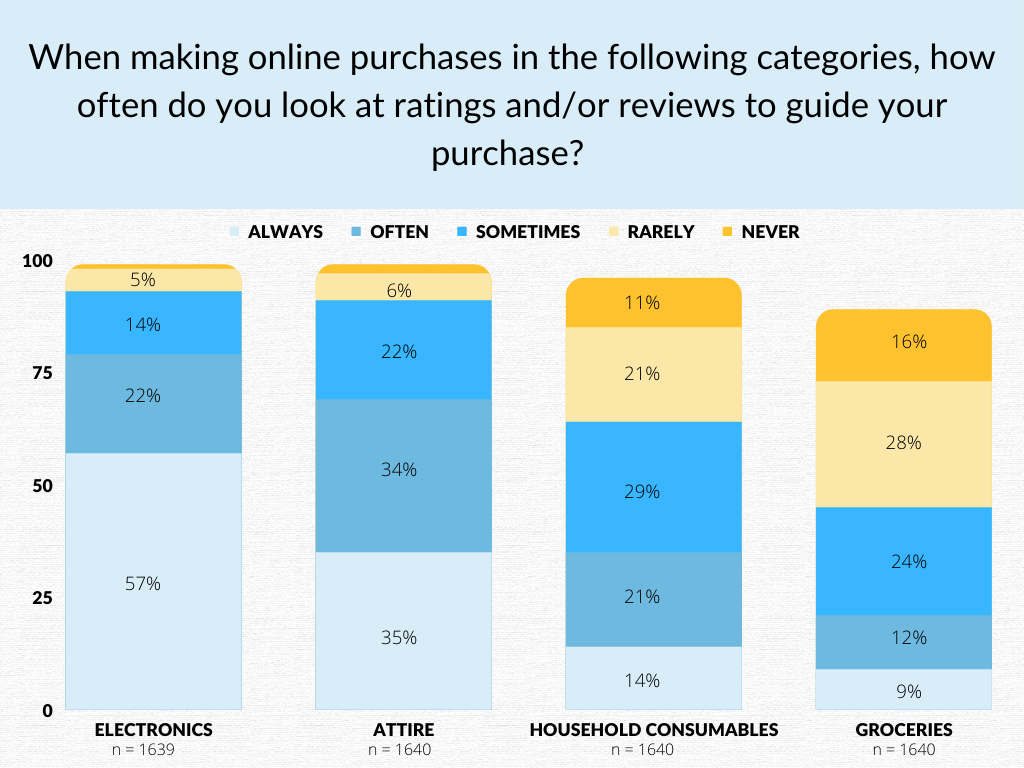
In a Field Agent survey of 1,640 shoppers* who make an online purchase every month on average, 9-in-10 respondents said they regularly read product reviews to guide their online purchases.
*All survey respondents were Canadian adults at least 18 years of age, smartphone owners, and members of the Field Agent mobile panel. The surveys were executed through the Field Agent platform, April 7-10 2022, with a non-random sample of shoppers.
By category, here’s the number of online shoppers who said they “always” or “often” look at ratings/reviews prior to making online purchases:
- Electronics: 79% (always or often look at customer reviews)
- Attire: 69%
- Household consumables: 35%
- Groceries: 21%
Moreover, 93%, 91%, 64%, and 45%, respectively, at least “sometimes” read product reviews before buying online.
Clearly, product reviews are a powerful force in retail—one brands and retailers absolutely can’t afford to get wrong.
But…
- Why exactly are product reviews so influential?
- How trustworthy do shoppers find reviews?
- And, how can companies ensure product reviews are building, not undermining, sales?
Welcome to this essential primer on online reviews.
The Essential Guide to Online Reviews: A Q&A
What are product reviews?
Sometimes called online reviews or customer reviews, a product review is a written or recorded description of a customer’s experience with a product, made available to shoppers as they consider the product for themselves. They’re an important and ubiquitous form of user-generated content (UGC) found across the internet.
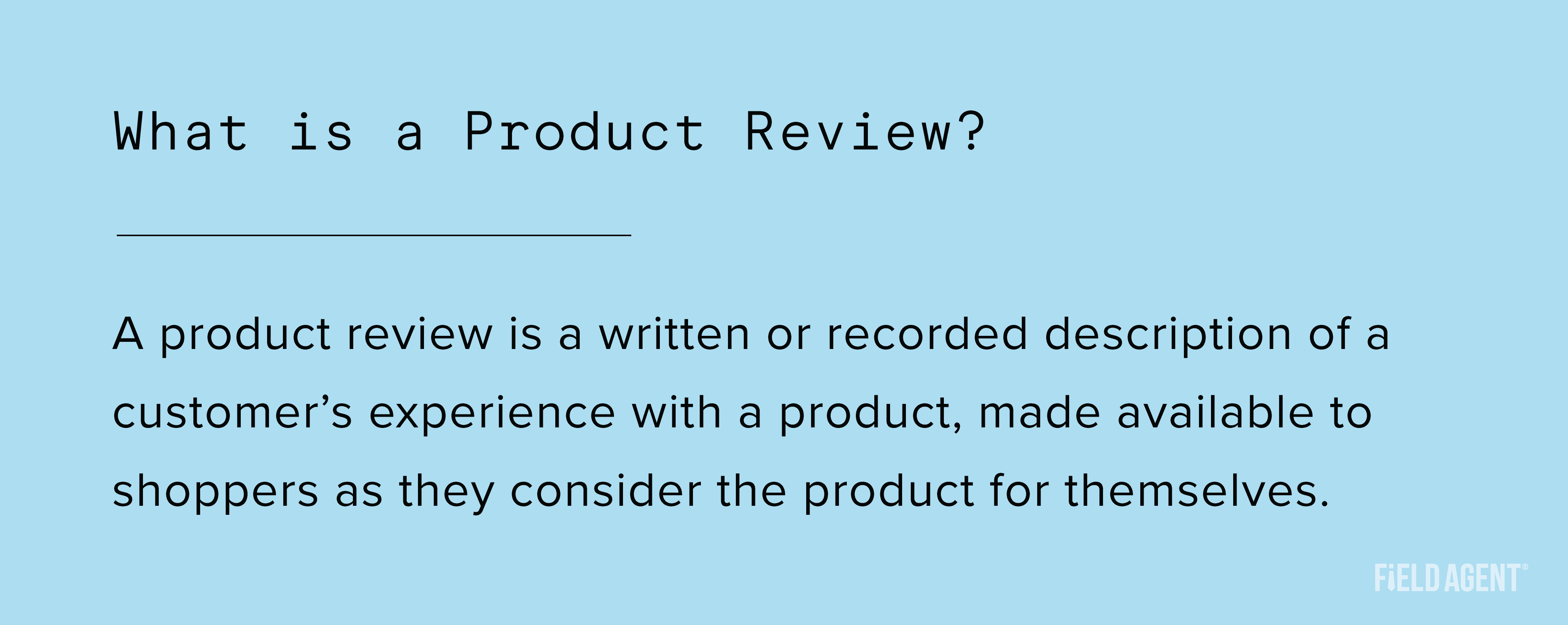
Review hotspots include Google My Business, Facebook, Yelp, and, of course, the many, many retailer.ca websites out there.
This primer is specifically focused on product reviews, the kind generally associated with ecommerce shopping and generally found at the bottom of product-detail pages (PDPs) on, for instance, Amazon and Walmart.ca.
Product reviews submitted to major ecommerce sites generally coincide with the submission of a product rating. A product rating is a numerical assessment, often expressed as a “star rating” (e.g., 4.5 stars), submitted by the reviewers of a product.
Together, product ratings and reviews represent a crucial form of WOM and social proof for shoppers, and a critical asset (or critical liability) for brands of all kinds.
Make no mistake, online reviews are an important part of your brand’s overall identity and equity.
How important are product reviews?
Let’s consider from the all-important perspective of sales.
Everything else is just a pretense, after all.
According to our survey of 1,640 online shoppers, 9-in-10 said product reviews are influential over their online purchases, and more than half said they’re highly influential.
But let’s get more specific, since review-readership varies from category to category.
As you can see below, 74% of online shoppers in our survey said reviews are “extremely” or “very” influential over their online purchases of electronics, and 58% over online attire purchases. Perhaps not surprisingly, online shoppers say reviews exert less of an effect over their online purchases of household consumables (28% answered extremely or very influential) and groceries (19%).
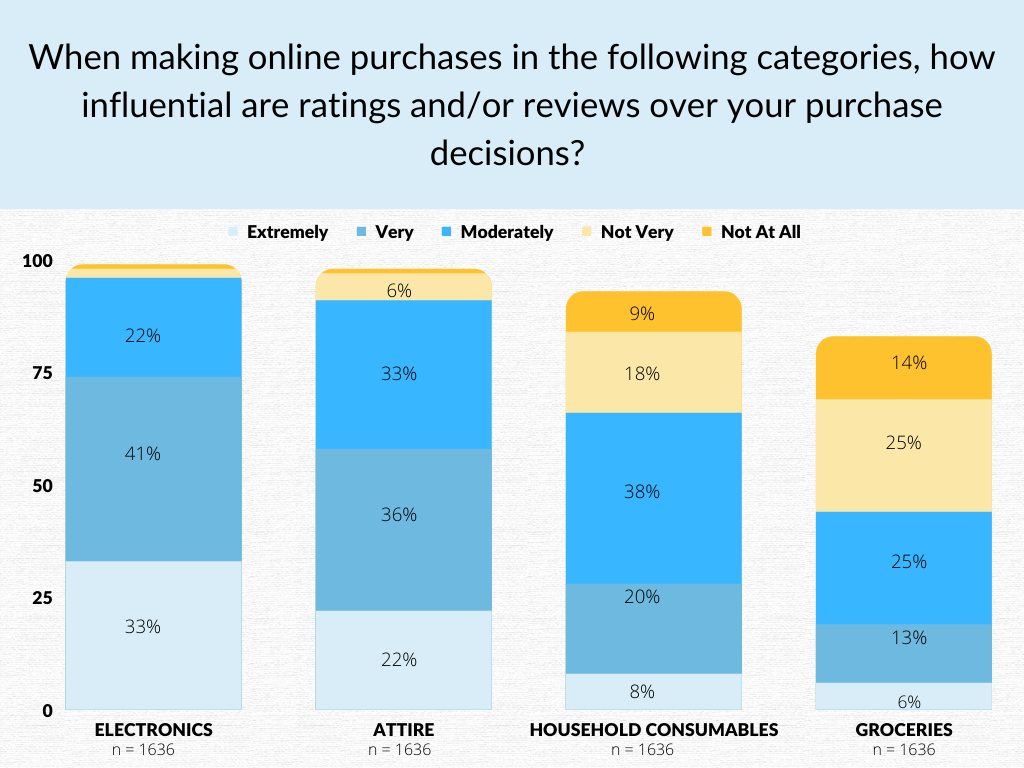
However, with online grocery-pickup (OGP) making such strong and irreversible gains with shoppers, we expect reviews to only become more influential over grocery/consumable purchases with each passing day.
But it’s not just online purchases that product reviews are influencing. They also impact in-store sales.
Among applicable respondents in our survey…
- 89% at least sometimes read online reviews prior to buying in–store electronics (n = 1,638)
- Attire in-store (n = 1,638) - 62%
- Household consumables in-store (n = 1,638) - 45%
- Groceries in-store (n = 1,638) - 32%
So, whether online or in-store, product reviews can really move the needle on sales.
That’s first and foremost why they matter.
Product Reviews Don't Have to Be Hard: Get Reviews Now
Why are product reviews important?
As seen because they influence sales so strongly. But how do product reviews influence sales?
One thing’s for sure: The answer is more than readily meets the eye. The tendency is to make online reviews—and their influence over purchases—a little too one-dimensional. Reviews impact sales in many ways—some of them a little surprising, perhaps.
- Buyer confidence
When a product has amassed a number of positive reviews, what the potential buyer sees is a record of satisfaction among other “real people” who’ve been there, bought that.
The product, in other words, has a history of satisfying buyers—and this suggests to other buyers they, too, will be satisfied.
The resulting confidence is just the push some buyers need to hit the buy button.
- Answers
- Are these jeans sized on the larger or smaller side?
- Does this playset come with action figures?
- How far will this curtain rod extend?
- Does this meal kit contain animal byproducts?
Online and in-store, would-be customers often have questions standing between them and making a first-time purchase of a product. Increasingly, however, they don’t rely on salespeople or marketing materials to answer those questions.
Instead, they seek out online reviews.
For shoppers, a lot of times: no answer = no purchase.
And reviews provide answers.
- Social proof
When people talk about the benefits of online reviews, they often mention that mysterious term “social proof.”
But what is social proof exactly?
Social proof has been described as a socio-psychological concept in which people emulate the actions of others within a specific behavioral situation.
Basically, we’re “copy cats.”
It’s why it’s so hard to get on the dance floor when no one else is dancing, and so easy when the dance floor is packed with people making fools of themselves.
And product reviews carry social proof. When potential customers see others buying a product, enjoying a product, and recommending a product…it’s like a crowded dance floor…and it’s easy (or at least easier) to do what everybody else is already doing...
Buying!
- Popularity
People like winners; people buy winners.
When a shopper sees a product with 1,000+ reviews and 4.5 stars at the top of a product page, it suggests popularity. Likewise, a lack of reviews, or a star-rating under 4 stars, may suggest something altogether different.
But is it really that big of a deal—that is, shoppers seeing that your product is a popular product?
In our survey of 1,640 online shoppers, 25% said they'll ignore even a good product—one they would otherwise buy—if it has no reviews.
More on this later, but, yeah, a perception of popularity—or, at least, a record of previous purchases by satisfied shoppers—is a big deal.
- SEO
To win purchases, increasingly brands have to first win over search engines.
And that’s where SEO, or search engine optimization, counts a lot.
First, consider Google.
Google’s algorithm may not weigh ratings and reviews directly, but reviews can most certainly influence your SERP (search engine results page) rankings. For instance, lots of reviews will make your product-detail pages more popular with shoppers—and that can move your product (specifically, your product pages) up those Google rankings.
Or, consider that a Google search for “Febreze spray” or “Reynolds aluminum foil” will return search results with links to product pages on retailer.com sites. And what do you see in those search listings—right there on Google SERPs? Usually you’ll see the product’s star rating as well as the number of reviews written about the product.
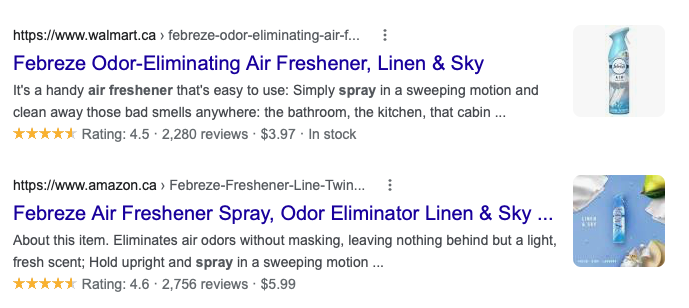
Second, consider retailer.ca sites.
Remember that practically any major ecommerce site not only has a search engine, but it is a search engine.
Lots of folks, even those not planning to make an online purchase from a particular retailer.com, will use the site's search engine to research their product purchases.
And, the retailer’s search engine does consider the quality and quantity of reviews in determining which products to serve up to shoppers as they conduct searches.
Ratings and reviews are often an important factor in a retailer.com's content quality score, as Walmart calls it.
Which has direct implications for how many shoppers will see your product. And sales.
- Retail buyers
For several reasons, online reviews can influence your retail buyer’s impression of your products and, consequently, influence sales both online and in-store.
Consider just two points…
First, retail buyers know the importance of customer reviews to the success of products, particularly online. Buyers, then, want—and sometimes demand—that brands find ways to outfit their product pages with more or better reviews.
Second, online is often a proving ground for products vying to land on store shelves. There’s simply more space online—lots more—than there is in-store. For this reason, buyers often want SKUs to win clicks before they’re trusted with “bricks.” And product reviews help products amass online purchases.
As we point out in our Buyer Meeting Success Kit, never forget that today's retail buyers are generally responsible for the entire omnichannel.
Consequently, these buyers care about online sales...and what happens there can influence their opinion of and openness to your brand anywhere else along the omnichannel.
Want to impress retail buyers? Up your online review game.
- Insights
Good or bad, positive or negative, when customers are talking about your products online, your brand is learning. Specifically, your brand’s learning:
- What customers think about your product
- How customers use your product
- How your product compares to other products
In this way, online reviews are an important forum for collecting insights about your customers—ideas, suggestions, complaints, and the like.
And a potential source of competitive advantage, especially over rival brands that may not enjoy as many reviews as you.
Do shoppers trust product reviews?
Of 1,640 online shoppers in our survey, a whopping 98% said they find product reviews at least moderately trustworthy when shopping for products online.
Forty-three percent, indeed, said they find them extremely or very trustworthy.
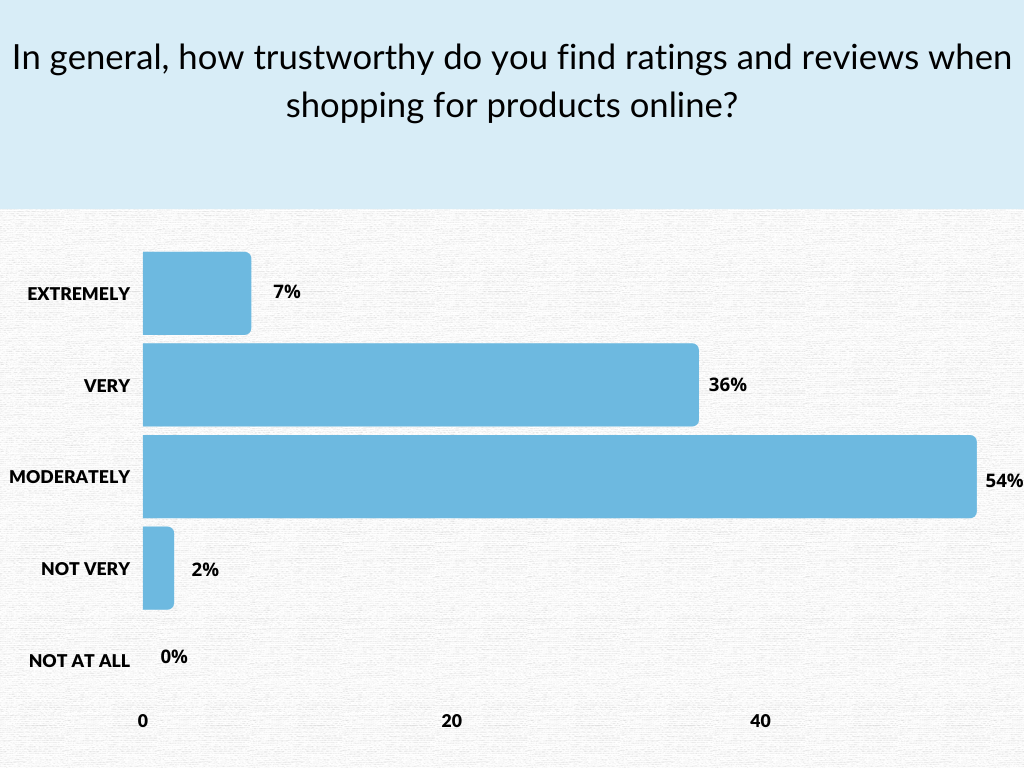
That’s quite a lot of trust.
Especially compared to advertisements, sales pitches, and other traditional modes of talking about products.
How do companies improve product reviews?
So, specifically, what’s a brand to do to improve product reviews?
We’ll get more specific in a moment, but first consider just three broad principles:

- Get Serious
First, know you can improve reviews. Often, however, this requires a fundamental shift in one’s thinking.
Brand professionals sometimes think of product reviews as something “out there,” something untouchable, or something just between customers.
But brands today are taking a more proactive, purposeful, and productive approach to online reviews.
Increasingly, companies are going after reviews, rather than waiting—dangerously—for reviews to come to them.
It starts by getting serious.
- Get More
As seen, it’s crucial for brands to have reviews, and to have them in sufficient quantities.
It’s important to shoppers, too.
In our survey of over 1,000 online shoppers, 9-in-10 said it’s important for products to have “more than just a few reviews,” while 7-in-10 said it’s very important.
But when is enough, you know, enough? When do you have enough reviews?
Here are some questions to consider.
Does a particular SKU of yours have enough reviews to…
- Suggest popularity?
Popularity, after all, is a relative concept. No product is absolutely popular; they’re only popular (or unpopular) relative to other products in the category. So, is your product more popular than rival products—and does it have enough reviews to prove it to shoppers?
- Provide adequate social proof?
To use the illustration from earlier, an empty dance floor (i.e., no reviews) doesn’t exactly encourage folks to bust a move (i.e., make a purchase). And a dance floor with just a few people (i.e., a few reviews) is hardly inspiring either. But crowd that dance floor with people letting loose (i.e., lots of reviews) and even the faint-hearted just have to be a part.
- Reach saturation?
Products like electronics and furniture have more features—and, frankly, more things to consider—than products like, say, window cleaner or snack cakes. Thus, as your product offerings grow in sophistication, the more user-generated content, including reviews, you’ll probably need to sufficiently satisfy shoppers’ questions and concerns about the product.
- Reflect the cost?
Relatively expensive products require greater investment and sacrifice from shoppers who, naturally, will be inclined to do more research than if they were buying something for a dollar or two. The higher the price tag = the more reviews you may need.
- Instill confidence?
This is what it all comes down to: Does the SKU in question have enough reviews to instill confidence in shoppers who are looking for any excuse not to buy from you?
More on this shortly, but it’s easier than ever for brands to get more ratings and reviews. Today, brands use streamlined tools like these to quickly generate more reviews in an instant—whenever and wherever they're needed.
- Get Fresh
Shoppers don’t just want sufficient numbers of reviews; they also want recent reviews.
In our survey, 68% of online shoppers said it’s either extremely or very important that “reviews were written recently (as opposed to 2-3 years ago).” Nine-in-ten, moreover, said it’s at least moderately important.
Shoppers know outdated reviews don’t necessarily reflect current realities. What was true three years ago, may not be true today.
Recent reviews, on the other hand, build up their confidence.
Consequently, brands need an ongoing review program that not only ensures sufficient numbers of reviews, but fresh reviews submitted recently.
How do companies get more product reviews?
Of course, the most fundamental response to this question: sell good stuff with great customer service. But, you know that already.
So how do brands go after reviews, rather than simply waiting for reviews to come to them—which may never happen?
Here are a few tactics for getting more online reviews:
- Ask for reviews
That’s right, ask for them. And there are several ways to go about this:
- Send a personalized email to customers after they purchase your product, demonstrating sincere concern for their experience/satisfaction but also taking the opportunity to request a review
- Send a broader email campaign targeted to the customers most likely to give you a review—and a positive one at that
- Include a fun, compelling product insert in every package you send, requesting a review from customers as soon as they open the package
- Enlist shoppers to buy, try, and review your product
Different retailer.com sites have different rules. Amazon, for instance, doesn’t allow companies to offer discounted or free products in exchange for reviews.
But practically all other ecommerce platforms do.
Today, brands can use solutions like these to enlist shoppers to buy, try, and, yes, review their products on sites like Walmart.ca, canadiantire.ca, bestbuy.ca and so on.
If you need authentic reviews from verified purchasers, just put in an order.
- Give something to get something
It’s human nature: When someone gives us something, we feel obligated to give something in return.
What does this look like in the world of ecommerce, brands, customers, and reviews?
Discounts, valuable content, swag, and the like can all make a customer feel you’re going above and beyond to create value for them. And perhaps they’ll go above and beyond for you—and write a review.
Only, strive to synchronize the giving with the requesting, so your exceptional service-quality is fresh on customers’ minds when you ask for a review.
What are common challenges to getting product reviews?
Brands wrestle with many different challenges in their quest to populate product-pages with sufficient numbers of positive reviews.
For instance…
- Shipping
Traditional review programs, by which brands try to amass online reviews, often require these companies to ship their products to consumers—who would then try them and, only then, write a review about them. Inconvenient.
- Giving away products
Conventional review programs also often necessitate giving away products—for free. The process of generating reviews is supposed to add to the bottom line, not take from it.
- Wait times
Due to shipping and other logistical requirements, traditional review programs aren’t exactly speedy. There are wait times for reviews, and some brands just can’t wait.
- Authenticity
Was the purchase authentic? Not if companies are shipping products to would-be reviews. Is the review authentic? Not if reviewers are incentivized only to post positive reviews with five-star ratings.
And inauthentic reviews don’t serve anyone well—not shoppers, not retailers, not even brands. The short-term gains of manipulating the system with inauthentic reviews will only ensure the system becomes less accessible to brands.
So how are brands overcoming these common challenges to getting more reviews?
One increasingly popular option: on-demand reviews.
What are on-demand reviews?
On-demand reviews work like this:
- Real shoppers are mobilized to purchase a specific product from a specific retailer (in-store or online)
- These individuals—who you can now properly call real customers—then take the product home, to their natural habitat, where they try it out
- Customers then post an authentic online review to a specified retailer.com or brand site
Simple yet effective.
Consider just a few benefits of on-demand reviews, that differentiate them from other approaches to garnering reviews…
- Actual sales. No giving away products for free. This means brands get a sales bump even as they get reviews.
- Real purchases under realistic purchase conditions
- Flexibility to direct shoppers to specific stores or specific ecommerce platforms
- Real trial under realistic trial circumstances (i.e., inside the home)
- No shipping. Shoppers purchase the product themselves—right off of shelves or right from ecommerce product pages. And no delivery means no nonsensical reviews like, “1 star - The delivery got here late and the package was damaged.” Cringe.
- Repurchase intentions. On-demand reviews gauge the likelihood reviewers will purchase the product again.
Field Agent offers several on-demand review options, as you can explore here.
At a the highest level, it’s a matter of making two decisions:
- The purchase location: in-store or online?
- The review location: retailer site, brand site, or syndicated?
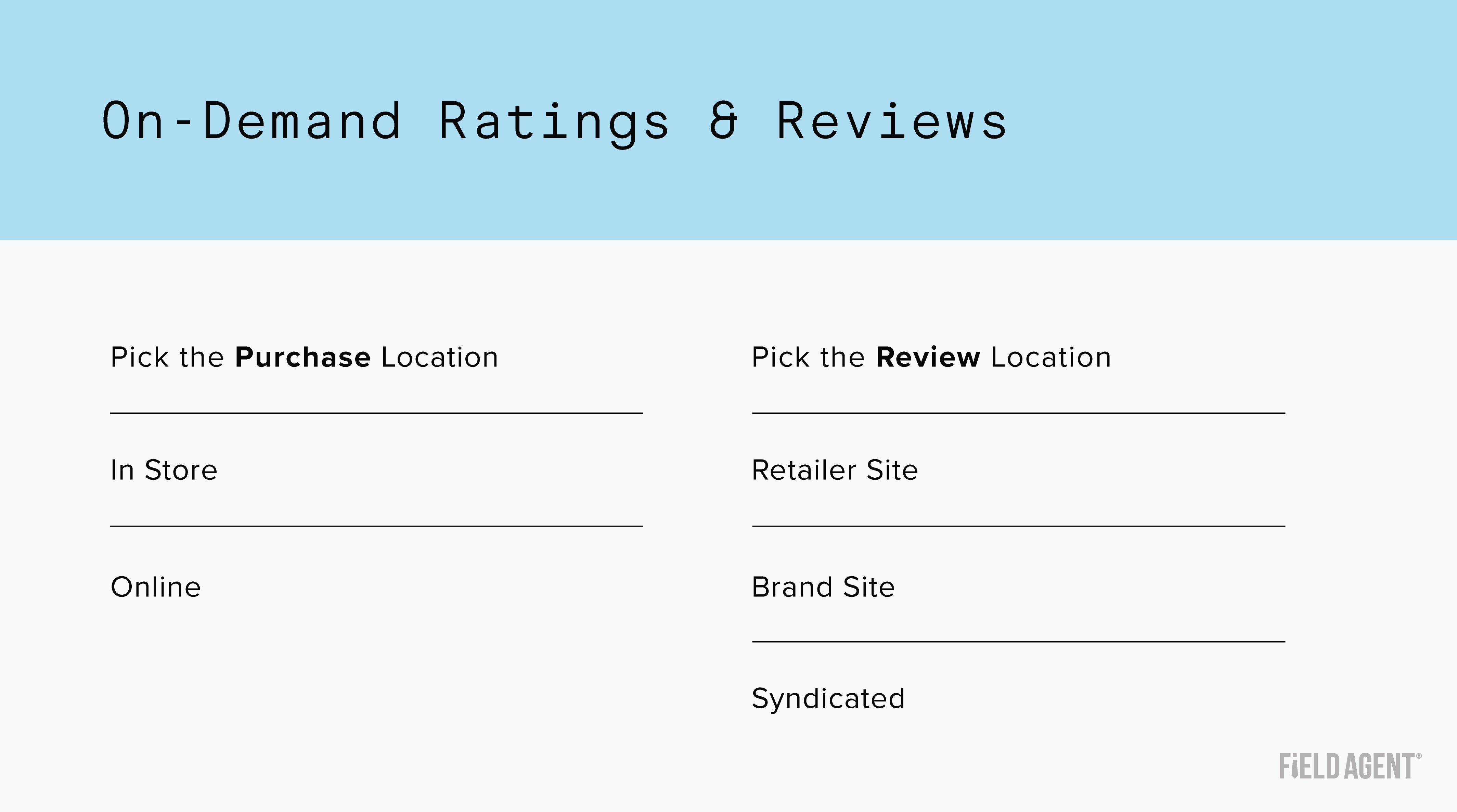
Of course, on-demand reviews also let you get specific about important questions like:
- From which specific market/store do you want a shopper to buy your product?
- Who (i.e., what demographics) should be targeted for the reviews?
In the graphic above, you can also see another advantage of on-demand reviews: the ability to syndicate. If you wish to spread a single review over more than one site, syndication is an attractive option.
Start Generating Reviews. Hassle-Free.
On-demand reviews are the fast, simple, authentic way to generate more reviews for your products. Answer just a few questions, and we activate shoppers to buy your products, try them at home, and, of course, leave authentic reviews on the site of your choice.
Click below to find out how Field Agent can help you gather online reviews:



